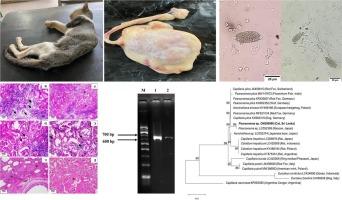First record of feline urinary bladder worm (Capillaria syn. Pearsonema) in Sri Lanka: Clinical, histopathological and molecular characterization
IF 1.4
Q3 PARASITOLOGY
Veterinary parasitology, regional studies and reports
Pub Date : 2024-09-24
DOI:10.1016/j.vprsr.2024.101117
引用次数: 0
Abstract
Nematode infections in the urinary tract of domestic cats and dogs are rare, although common in wild predatory animals. Here we report a case of a urinary bladder capillariosis in a cat from Sri Lanka. A three-year-old domestic male cat from the Kalutara District was brought to a private veterinary hospital due to frequent urination, vomiting, and loss of appetite. The physical examinations reported severe emaciation, gasping and abdominal breathing and retarded growth. Successive to urinary sedimentation, Capillaria-type eggs were detected. Blood Urea Nitrogen level of 28.02 Mmol/L and serum creatinine level of 0.42 mmol/L were higher than the normal ranges. Necropsy revealed an enlarged left kidney with oedematous renal parenchyma. Following the histopathological examination, multifocal areas of tubular degeneration and necrosis with multifocal fibroblast proliferation were observed in the renal cortex. The lungs showed diffuse pulmonary oedema and chronic interstitial pneumonia. Molecular analysis with PCR and DNA sequencing of the Capillaria-type eggs in sedimented urine, using an amplicon (18S rRNA) for Capillaria (563 bp) followed by phylogenetic analysis revealed a 100 % identity to Pearsonema collected from the urinary bladder of a raccoon from Japan. Cases of Capillaria in cats are rarely reported because most infected animals do not show clinical signs. This is the first case report of Capillaria syn. Pearsonema sp. identifies and characterizes the species using molecular tools and describes the infection's clinical symptoms.

斯里兰卡首次记录到猫膀胱蠕虫(Capillaria syn:临床、组织病理学和分子特征描述
家猫和家犬的泌尿道线虫感染很少见,但在野生食肉动物中却很常见。在此,我们报告了一例斯里兰卡猫的膀胱毛滴虫病。卡卢塔拉地区有一只三岁大的家养雄猫,因频繁排尿、呕吐和食欲不振被送到一家私人兽医院。体格检查报告称,该猫严重消瘦、喘息和腹式呼吸,生长发育迟缓。尿沉渣中发现了毛囊虫卵。血尿素氮水平为28.02毫摩尔/升,血清肌酐水平为0.42毫摩尔/升,均高于正常范围。解剖发现左肾肿大,肾实质水肿。组织病理学检查显示,肾皮质出现多灶性肾小管变性和坏死,并伴有多灶性成纤维细胞增生。肺部出现弥漫性肺水肿和慢性间质性肺炎。通过对沉积尿液中的毛囊虫卵进行聚合酶链式反应(PCR)和 DNA 测序,使用毛囊虫的扩增子(18S rRNA)(563 bp)进行分子分析,然后进行系统发育分析,结果显示与从日本一只浣熊的膀胱中采集的皮尔森菌 100%相同。猫感染毛囊虫的病例很少见报道,因为大多数受感染的动物不会出现临床症状。这是第一份关于Capillaria syn. Pearsonema sp.的病例报告,它利用分子工具确定了该物种的特征,并描述了感染的临床症状。
本文章由计算机程序翻译,如有差异,请以英文原文为准。
求助全文
约1分钟内获得全文
求助全文
来源期刊
CiteScore
2.90
自引率
7.10%
发文量
126
审稿时长
97 days
期刊介绍:
Veterinary Parasitology: Regional Studies and Reports focuses on aspects of veterinary parasitology that are of regional concern, which is especially important in this era of climate change and the rapid and often unconstrained travel of people and animals. Relative to regions, this journal will accept papers of the highest quality dealing with all aspects of disease prevention, pathology, treatment, epidemiology, and control of parasites within the field of veterinary medicine. Also, case reports will be considered as they add to information related to local disease and its control; such papers must be concise and represent appropriate medical intervention. Papers on veterinary parasitology from wildlife species are acceptable, but only if they relate to the practice of veterinary medicine. Studies on vector-borne bacterial and viral agents are suitable, but only if the paper deals with vector transmission of these organisms to domesticated animals. Studies dealing with parasite control by means of natural products, both in vivo and in vitro, are more suited for one of the many journals that now specialize in papers of this type. However, due to the regional nature of much of this research, submissions may be considered based upon a case being made by the author(s) to the Editor. Circumstances relating to animal experimentation must meet the International Guiding Principles for Biomedical Research Involving Animals as issued by the Council for International Organizations of Medical Sciences (obtainable from: Executive Secretary C.I.O.M.S., c/o W.H.O., Via Appia, CH-1211 Geneva 27, Switzerland).

 求助内容:
求助内容: 应助结果提醒方式:
应助结果提醒方式:


